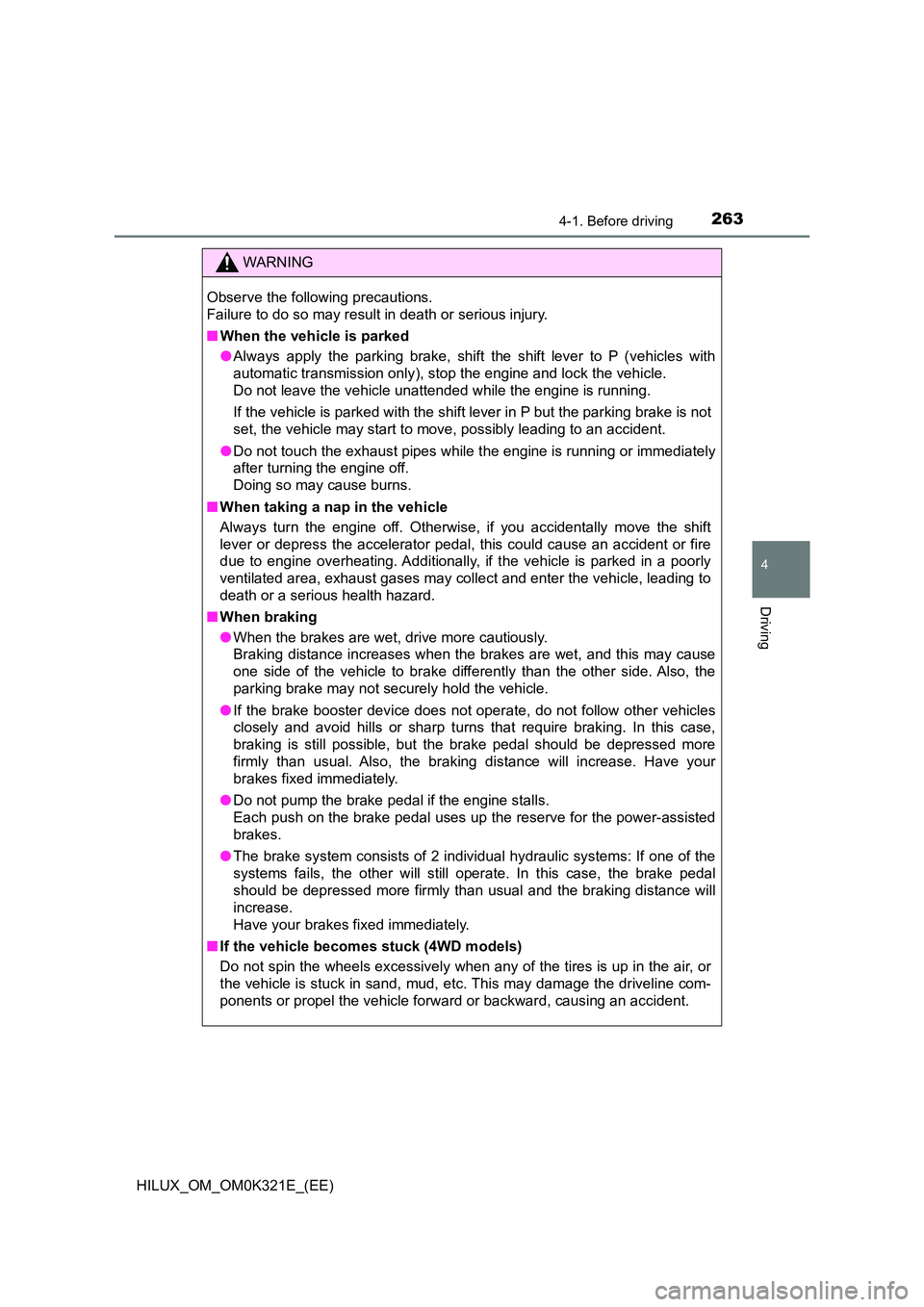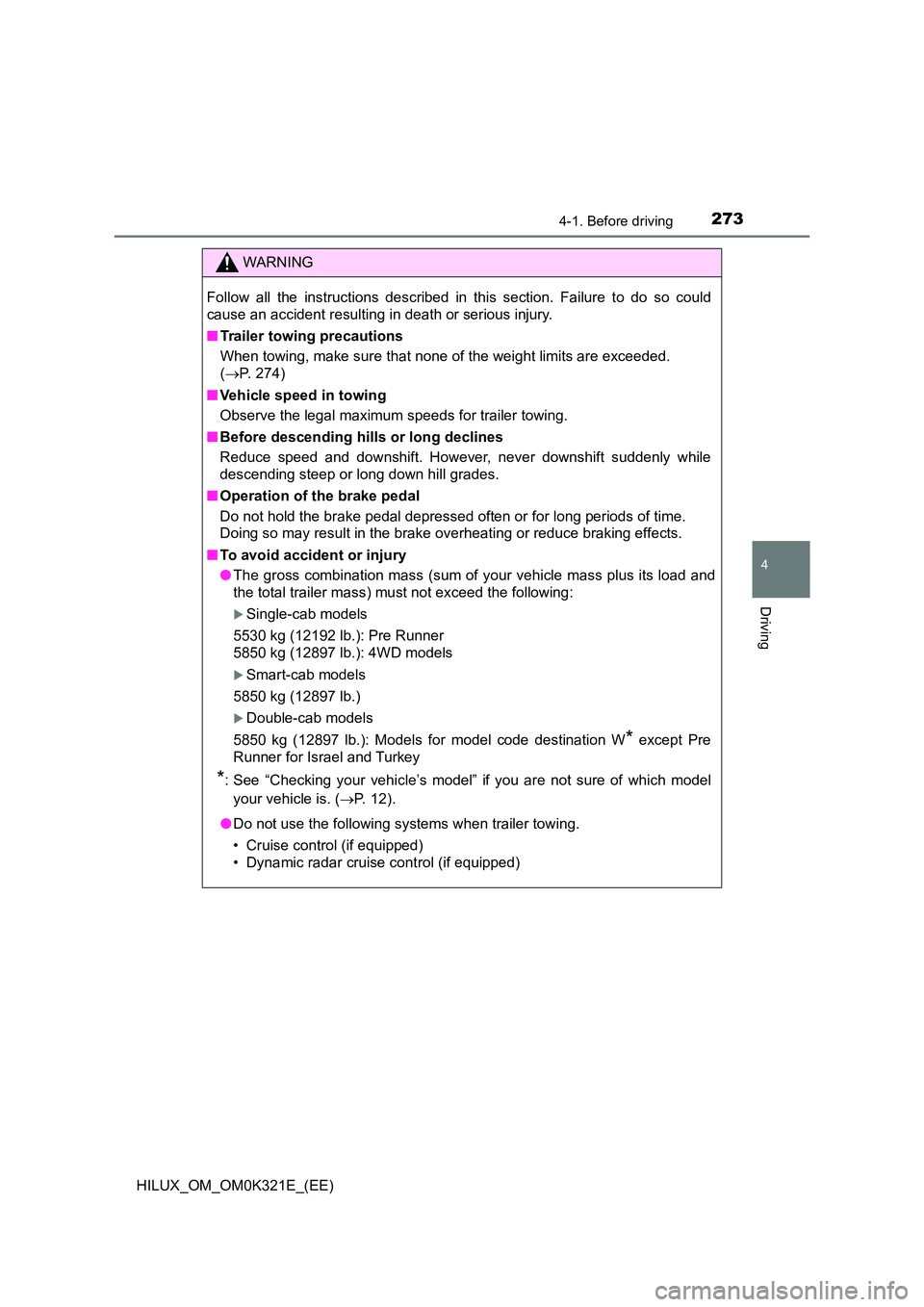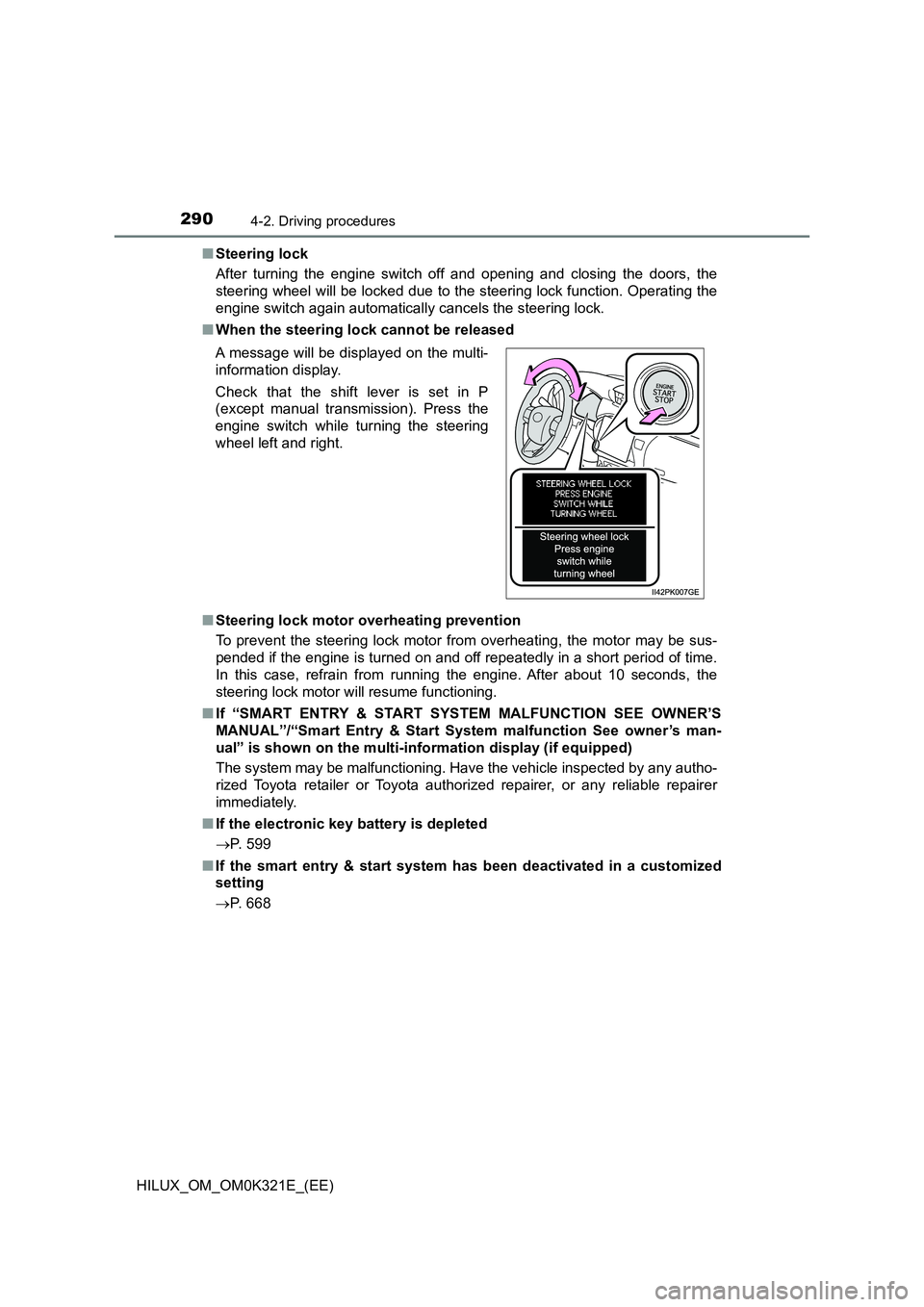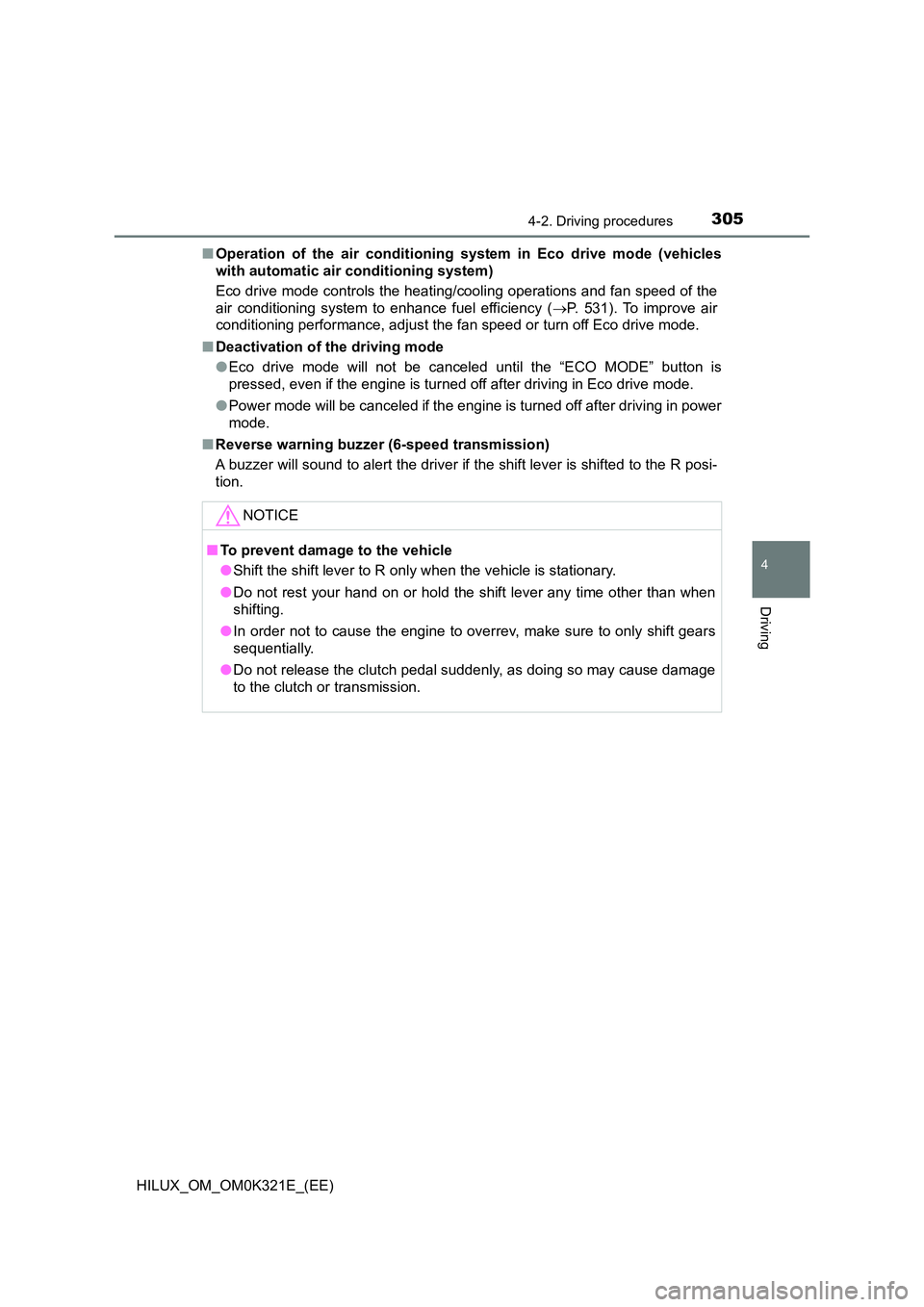2020 TOYOTA HILUX heating
[x] Cancel search: heatingPage 138 of 744

1382. Instrument cluster
HILUX_OM_OM0K321E_(EE)
The indicators inform the driver of the operating state of the vehicle’s
various systems.
Indicators
Turn signal indicator
( P. 306)(if equipped)
Dynamic radar cruise
control indicator
( P. 367)
Headlight high beam
indicator ( P. 310)(if equipped)
Cruise control “SET”
indicator ( P. 367, 383)
Tail light indicator
( P. 308)(if equipped)
“ECO MODE” indicator
( P. 295, 301)
(if equipped)
Front fog light indicator
( P. 315)(if equipped)
“PWR MODE” indicator
( P. 295, 301)
(if equipped)
Rear fog light indicator
( P. 316)
*1
(if equipped)
Downhill assist control
system indicator
( P. 430)
*1Eco Driving Indicator
Light ( P. 140)
*1, 2
(if equipped)
Slip indicator (P. 423)
*1
(if equipped)
Stop & Start indicator
( P. 412)
*1, 3
(if equipped)
VSC OFF indicator
( P. 424)
*1
(if equipped)
Stop & Start cancel
indicator ( P. 413)
*1, 3
(if equipped)
“TRC OFF” indicator
( P. 424)
(diesel engine)
Engine preheating
indicator ( P. 282, 285)(4WD models)
Four-wheel drive
indicator ( P. 398)
(if equipped)
Cruise control indicator
( P. 367, 383)(4WD models)
Low speed four-wheel
drive indicator light
( P. 398)
Page 146 of 744

1462. Instrument cluster
HILUX_OM_OM0K321E_(EE)
■ Outside temperature display
In the following situations, the correct outside temperature may not be dis-
played, or the display may take longer than normal to change:
● When the vehicle is stopped, or moving at low speeds (less than 20 km/h
[12 mph])
● When the outside temperature has changed suddenly (at the entrance/exit
of a garage, tunnel, etc.)
■ When “--” is displayed
The system may be malfunctioning. Take your vehicle to any authorized
Toyota retailer or Toyota authorized repairer, or any reliable repairer.
WARNING
■ The information display at low temperatures (vehicles with multi-infor-
mation display type B)
Allow the interior of the vehicle to warm up before using the liquid crystal
information display. At extremely low temperatures, the display monitor may
respond slowly, and display changes may be delayed.
For vehicles with automatic transmission: For example, there is a lag
between the driver’s shifting and the new gear number appearing on the
display. This lag could cause the driver to downshift again, causing rapid
and excessive engine braking and possibly an accident resulting in death or
injury.
NOTICE
■ To prevent damage to the engine and its components
● Do not let the indicator needle of the tachometer enter the red zone, which
indicates the maximum engine speed.
● The engine may be overheating if the engine coolant temperature gauge is
in the red zone (H). In this case, immediately stop the vehicle in a safe
place, and check the engine after it has cooled completely. ( P. 678)
■ The information display at low temperatures (vehicles with multi-infor-
mation display type A)
Allow the interior of the vehicle to warm up before using the liquid crystal
information display. At extremely low temperatures, the display monitor may
respond slowly, and display changes may be delayed.
Page 263 of 744

2634-1. Before driving
4
Driving
HILUX_OM_OM0K321E_(EE)
WARNING
Observe the following precautions.
Failure to do so may result in death or serious injury.
■ When the vehicle is parked
● Always apply the parking brake, shift the shift lever to P (vehicles with
automatic transmission only), stop the engine and lock the vehicle.
Do not leave the vehicle unattended while the engine is running.
If the vehicle is parked with the shift lever in P but the parking brake is not
set, the vehicle may start to move, possibly leading to an accident.
● Do not touch the exhaust pipes while the engine is running or immediately
after turning the engine off.
Doing so may cause burns.
■ When taking a nap in the vehicle
Always turn the engine off. Otherwise, if you accidentally move the shift
lever or depress the accelerator pedal, this could cause an accident or fire
due to engine overheating. Additionally, if the vehicle is parked in a poorly
ventilated area, exhaust gases may collect and enter the vehicle, leading to
death or a serious health hazard.
■ When braking
● When the brakes are wet, drive more cautiously.
Braking distance increases when the brakes are wet, and this may cause
one side of the vehicle to brake differently than the other side. Also, the
parking brake may not securely hold the vehicle.
● If the brake booster device does not operate, do not follow other vehicles
closely and avoid hills or sharp turns that require braking. In this case,
braking is still possible, but the brake pedal should be depressed more
firmly than usual. Also, the braking distance will increase. Have your
brakes fixed immediately.
● Do not pump the brake pedal if the engine stalls.
Each push on the brake pedal uses up the reserve for the power-assisted
brakes.
● The brake system consists of 2 individual hydraulic systems: If one of the
systems fails, the other will still operate. In this case, the brake pedal
should be depressed more firmly than usual and the braking distance will
increase.
Have your brakes fixed immediately.
■ If the vehicle becomes stuck (4WD models)
Do not spin the wheels excessively when any of the tires is up in the air, or
the vehicle is stuck in sand, mud, etc. This may damage the driveline com-
ponents or propel the vehicle forward or backward, causing an accident.
Page 272 of 744

2724-1. Before driving
HILUX_OM_OM0K321E_(EE)
■Important points regarding stability
Vehicle movement resulting from uneven road surfaces and strong
crosswinds will affect handling. The vehicle may also be rocked by
passing buses or large trucks. Frequently check behind when mov-
ing alongside such vehicles. As soon as such vehicle movement
occurs, immediately start to decelerate smoothly by slowly applying
the brakes. Always steer the vehicle straight ahead while braking.
■Passing other vehicles
Consider the total combined length of your vehicle and trailer and
ensure that the vehicle-to-vehicle distance is sufficient before exe-
cuting lane changes.
■Transmission information
Vehicles with manual transmission: To maintain engine braking effi-
ciency when using engine braking, do not use 5th gear and 6th
gear.
Vehicles with automatic transmission: To maintain engine braking
efficiency when using engine braking, do not use the transmission
in D. Transmission shift range position must be in 4 or lower, in S
mode.
■If the engine overheats
Towing a loaded trailer up a long, steep incline in temperatures
exceeding 30 C (85F) may result in the engine overheating. If the
engine coolant temperature gauge indicates that the engine is over-
heating, turn the air conditioning off immediately, leave the road and
stop the vehicle in a safe place. ( P. 678)
■When parking the vehicle
Always place wheel chocks under the wheels of both the vehicle
and trailer. Firmly set the parking brake and shift the shift lever to P
for automatic transmissions, and 1 or R for manual transmissions.
Page 273 of 744

2734-1. Before driving
4
Driving
HILUX_OM_OM0K321E_(EE)
WARNING
Follow all the instructions described in this section. Failure to do so could
cause an accident resulting in death or serious injury.
■ Trailer towing precautions
When towing, make sure that none of the weight limits are exceeded.
( P. 2 7 4 )
■ Vehicle speed in towing
Observe the legal maximum speeds for trailer towing.
■ Before descending hills or long declines
Reduce speed and downshift. However, never downshift suddenly while
descending steep or long down hill grades.
■ Operation of the brake pedal
Do not hold the brake pedal depressed often or for long periods of time.
Doing so may result in the brake overheating or reduce braking effects.
■ To avoid accident or injury
● The gross combination mass (sum of your vehicle mass plus its load and
the total trailer mass) must not exceed the following:
Single-cab models
5530 kg (12192 lb.): Pre Runner
5850 kg (12897 lb.): 4WD models
Smart-cab models
5850 kg (12897 lb.)
Double-cab models
5850 kg (12897 lb.): Models for model code destination W* except Pre
Runner for Israel and Turkey
*: See “Checking your vehicle’s model” if you are not sure of which model
your vehicle is. ( P. 1 2 ) .
● Do not use the following systems when trailer towing.
• Cruise control (if equipped)
• Dynamic radar cruise control (if equipped)
Page 290 of 744

2904-2. Driving procedures
HILUX_OM_OM0K321E_(EE)
■ Steering lock
After turning the engine switch off and opening and closing the doors, the
steering wheel will be locked due to the steering lock function. Operating the
engine switch again automatically cancels the steering lock.
■ When the steering lock cannot be released
■ Steering lock motor overheating prevention
To prevent the steering lock motor from overheating, the motor may be sus-
pended if the engine is turned on and off repeatedly in a short period of time.
In this case, refrain from running the engine. After about 10 seconds, the
steering lock motor will resume functioning.
■ If “SMART ENTRY & START SYSTEM MALFUNCTION SEE OWNER’S
MANUAL”/“Smart Entry & Start System malfunction See owner’s man-
ual” is shown on the multi-information display (if equipped)
The system may be malfunctioning. Have the vehicle inspected by any autho-
rized Toyota retailer or Toyota authorized repairer, or any reliable repairer
immediately.
■ If the electronic key battery is depleted
P. 599
■ If the smart entry & start system has been deactivated in a customized
setting
P. 668
A message will be displayed on the multi-
information display.
Check that the shift lever is set in P
(except manual transmission). Press the
engine switch while turning the steering
wheel left and right.
Page 297 of 744

2974-2. Driving procedures
4
Driving
HILUX_OM_OM0K321E_(EE)
■S mode
When the shift range is 4 or lower, holding the shift lever toward “+” sets the
shift range to 6.
■ Downshifting restrictions warning buzzer
To help ensure safety and driving per formance, downshifting operation may
sometimes be restricted. In some circumstances, downshifting may not be
possible even when the shift lever is operated. (A buzzer will sound twice.)
■ Operation of the air conditioning system in Eco drive mode (vehicles
with automatic air conditioning system)
Eco drive mode controls the heating/cooling operations and fan speed of the
air conditioning system to enhance fuel efficiency ( P. 531). To improve air
conditioning performance, adjust the fan speed or turn off Eco drive mode.
■ Deactivation of the driving mode
● Eco drive mode will not be canceled until the “ECO MODE” switch is
pressed, even if the engine is turned off after driving in Eco drive mode.
● Power mode will be canceled if the engine is turned off after driving in power
mode.
■ When driving with cruise control or dynamic radar cruise control acti-
vated (if equipped)
Even when performing the following actions with the intent of enabling engine
braking, engine braking will not activate because cruise control or dynamic
radar cruise control will not be canceled.
● While driving in S mode, downshifting to 5 or 4. (P. 296)
● When switching the driving mode to power mode while driving in D.
( P. 295)
■ Shift lock system
The shift lock system is a system to prevent accidental operation of the shift
lever in starting.
The shift lever can be shifted from P only when the engine switch is in the
“ON” position (vehicles without smart entry & start system) or IGNITION ON
mode (vehicles with smart entry & start system) and the brake pedal is being
depressed.
Page 305 of 744

3054-2. Driving procedures
4
Driving
HILUX_OM_OM0K321E_(EE)
■ Operation of the air conditioning system in Eco drive mode (vehicles
with automatic air conditioning system)
Eco drive mode controls the heating/cooling operations and fan speed of the
air conditioning system to enhance fuel efficiency ( P. 531). To improve air
conditioning performance, adjust the fan speed or turn off Eco drive mode.
■ Deactivation of the driving mode
● Eco drive mode will not be canceled until the “ECO MODE” button is
pressed, even if the engine is turned off after driving in Eco drive mode.
● Power mode will be canceled if the engine is turned off after driving in power
mode.
■ Reverse warning buzzer (6-speed transmission)
A buzzer will sound to alert the driver if the shift lever is shifted to the R posi-
tion.
NOTICE
■ To prevent damage to the vehicle
● Shift the shift lever to R only when the vehicle is stationary.
● Do not rest your hand on or hold the shift lever any time other than when
shifting.
● In order not to cause the engine to overrev, make sure to only shift gears
sequentially.
● Do not release the clutch pedal suddenly, as doing so may cause damage
to the clutch or transmission.